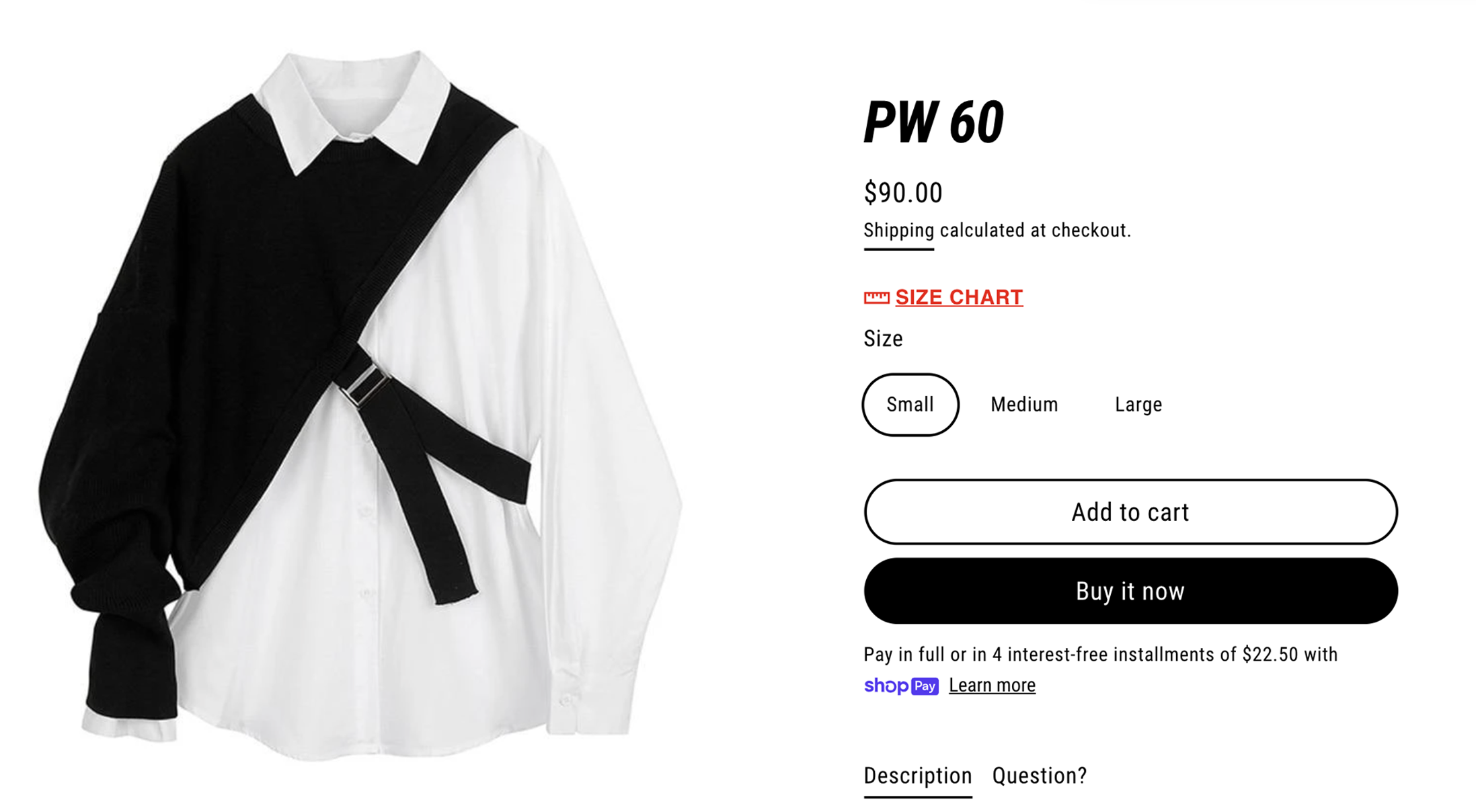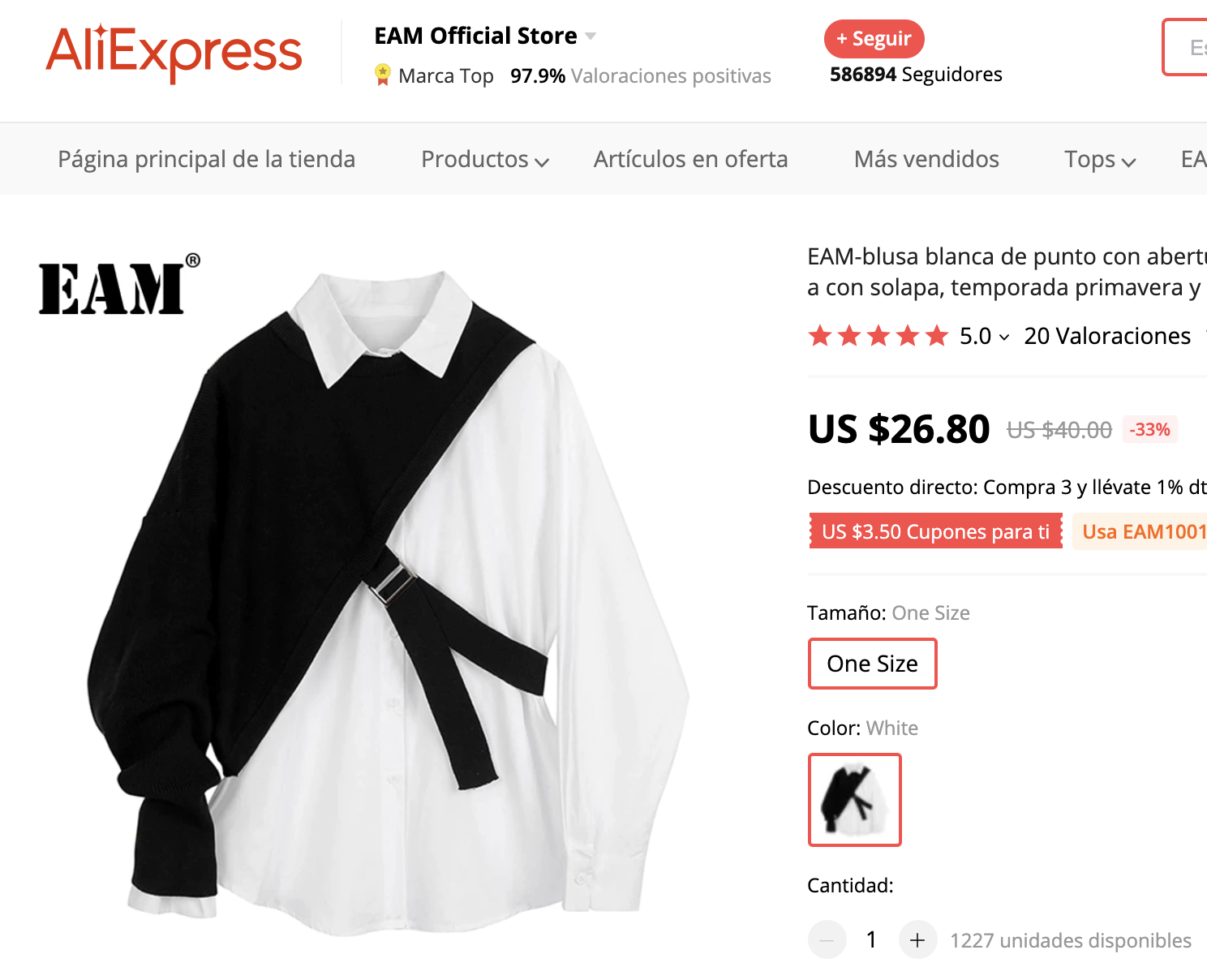A few months ago, I came across a fashion brand on Instagram that purported to be a Los Angeles-based, woman-owned boutique. The tagline on its Instagram bio, “Alteration is innovation,” suggested that the brand championed clothing alteration and sold clothes that were upcycled or crafted out of old and discarded fabrics.
The only red flag was the price of its clothes, which ranged from $60 to $150. These weren’t fast fashion prices, but they seemed suspiciously low for handcrafted garments. A quick reverse image search of the brand’s products confirmed my doubts. The Google results took me to another Instagram boutique as well as to AliExpress, a Chinese marketplace site, where the exact pieces (with the same promotional images) were sold for less than half of the stated price.
I was stunned. The quirky styles and marketing had led me to think that the brand produced and designed its own clothes, rather than sourcing pre-made styles from overseas manufacturers. Instead, like the many, many other “ghost stores” floating around the Instagram abyss, it appeared to be just another cog — albeit a barely identifiable one — in the fast fashion machine. (The brand did not reply to requests for comment.)
Instagram has spent years tweaking its interface, priming users to shop on the app. Its transformation into a shopping destination was swift, sudden, and hardly surprising. This paved the way for a specific type of online business, or “Insta boutique,” to thrive. These shops don’t always sell goods exclusively on Instagram; they rely on the app to draw customers to their websites, through influencer marketing or targeted ads. And while more people are turning to social media to find new products and brands, shoppers have also grown wary.
People are realizing that certain brands aren’t exactly what they market themselves to be: independent, ethically-minded stores run by small business owners and designers. In some cases, shoppers are finding out that they paid at least double the price of a garment found on marketplace sites like YesStyle, Amazon, and AliExpress, or from the Chinese fast fashion retailer Shein. For example, a Business Insider reporter purchased two dresses for about $34 each from It’s Juliet, an Instagram boutique that claims to sell “ethically made” clothing, only to discover the exact same styles on AliExpress for $10 each.
What’s concerning for customers is the origins of the merchandise in question. While some brands are clearly snapping up items from places like Amazon or Shein and reselling them for profit, others appear to be engaging in a practice where they don’t have merchandise on hand at all, called “drop shipping.” (Granted, not all stores on Instagram fall into this category. There are plenty of reputable, small artisans and business owners earning a living through the app.)
These virtual storefronts are what I refer to as “ghost stores:” faceless, indistinguishable enterprises with few original products. These merchants rarely disclose the nuances of their business models. Even those that do vaguely impart some information to shoppers aren’t immune from consumer blowback either. That’s because the entrepreneurs behind these brands are savvy at constructing a digital facade. They’ve learned to gain customers’ trust through relentless social media marketing or by manufacturing a convincingly vague “brand story” that reveals minimal information about founders and workers.
The draw of these “ghost stores” is predicated on somewhat ineffable factors. We buy from the brands we do because we connect with some element of the business, whether it be over superficial factors like unique clothing designs or something more identity-driven and moralistic, like sustainability. When we learn that a company isn’t much more than the story it’s telling — that it exists for purely profitable reasons — it can feel misleading. It is, of course, in every brand’s best interest to spin a narrative that attracts customers. One could argue that the entire retail industry is built on some level of deception.
Customers, too, haven’t traditionally cared about where or how their stuff is made. After all, plenty of reputable retailers have a history of sourcing from the same factories and suppliers, while resorting to white labeling, or rebranding, their items to disguise this fact. Still, the illusion of difference and exclusiveness is comforting. It cements a sense of loyalty between the customer and the brand. Back when we did most of our shopping at brick-and-mortar stores, this pretension felt believable. Now, all it takes is a simple Google search for the facade to fall apart.
Capitalism defined: All stores in U.S. do this; order wholesale clothing from over seas or have made in bulk for pennies & price it up 200-500% for resale. From IG Boutiques, to Macy’s. Small businesses aren’t scamming you, you’re just learning the inside of the retail industry.
— Corrinn The Creative (@beautyboxstyle) August 26, 2021
To be clear, reselling and drop shipping are not illegal or inherently nefarious practices, although factors like product quality and authentication come into question. Drop shipping is actually a decades-old fulfillment model initially used by furniture and appliance sellers. Merchants list products for sale without having any of the inventory on hand. The merchant is in agreement with manufacturers to purchase the products at lower wholesale prices, which allows them to mark up the cost for profit. When an item is sold, the drop shipper coordinates with the supplier to send the goods directly to the customer. It’s often a process the merchant has no control over, and items can take weeks or months to arrive.
Other ghost stores carry limited merchandise on hand and store it in a studio or warehouse. These virtual brands aren’t exactly drop shippers, since they have access to inventory. Still, they tend to buy wholesale from suppliers, like Shein or AliExpress, that work with drop shippers. The Instagram clothing store I encountered, for example, displays photos and videos of its Los Angeles studio and showroom, and occasionally features workers handling and shipping out garments. This is at odds with how its clothes are largely indistinguishable from that of EAM, an AliExpress store and supplier, and other Instagram boutiques.
Reproducibility is a telltale sign that these brands source from the same suppliers, even while they feign authenticity and originality. The muddied similarities between various online stores, made possible by the rise of shoppable social media and mass production of goods, reveal the reality of these ventures. It lays bare what the writer Jenny O’Dell described as “the categorical deception at the heart of all branding and retail.” Consumers are starting to notice and question, for example, why they’re seeing the same pair of pants everywhere, just with a different brand label slapped on. The purchase starts to feel like a scam, even if it isn’t quite.
Lisa Fevral, an artist from Canada who produces video essays on fashion and culture, has grown suspicious of a particular genre of small Instagram boutiques, selling trendy clothing styles and aggressively promoting targeted ads. In a recent video, Fevral referred to them as “doppelganger brands.” They have names like Cider, Kollyy, Omighty, Emmiol, and Juicici, and in her opinion appeared to sell clothes from the same Chinese suppliers. (Fevral was initially approached by a representative from Cider to promote the brand, but said she turned down the offer.) What worries Fevral, though, is the effort put into greenwashing their brands to deceive credulous customers.
“These companies are clearly targeting young women, but it seems like they’re trying to adjust their language to appear more sustainable or ethical while not changing much about their practices,” Fevral told me. “There’s no way any company can keep up with TikTok styles and trends unless they are producing a lot of very cheap clothing.”
Cider, which Business of Fashion has described as “the next Shein,” received $22 million of venture capital investment in June to expand its operations. On Cider’s “about us” page, it claims to be a “globally-minded, social-first” brand that reduces waste by operating under a preorder model and “only [produces] specific styles we know people want in a controlled amount.” Its CEO also told Business of Fashion that Cider places orders for small batches of styles. Yet customers have claimed to find copies of its clothes on AliExpress for slightly lower prices, which suggests that Cider — or its suppliers — might be producing and selling extra garments elsewhere. (Cider did not respond to requests for comment over email or Instagram.)
“It’s so easy for a brand to add another section in its about page to make you feel better about supporting them,” Fevral said. “Cider reached out to me even after I made the video [about its greenwashing practices]. These brands don’t care.”
It doesn’t really matter whether sites like Cider are drop shippers or merchants with access to wholesale merchandise. They’re not breaking any laws. In fact, the conspicuousness of the entire enterprise — how exact replicas of certain products can be found on other retail sites for comparable prices — is a defining quality of capitalism. What happens if a brand’s reputation is sullied? Its architects can simply rename it, start over, and continue to source from the same places. One frustrated shopper, who purchased a pleather jacket from a seemingly real German label, remarked that these “scams are getting so sophisticated” that people should be wary of buying things from digital brands they’ve never heard of.
Good morning! Instagram/Facebook clothing company scams are getting so sophisticated that if you don’t want to fall for one, you basically just can’t buy from digital brands you’ve never heard of. Signed, bozo who fell for the “Mark & Morten” “going out of business sale”
— Anna Sproul-Latimer (@annasproul) August 13, 2020
That’s because there is basically no friction to constructing a virtual storefront, even if it is essentially a digital facade. An aspiring retailer only needs a few things: a website, a catchy domain name, an active social media presence, and product suppliers. (Shein is a preeminent example of this kind of direct-to-consumer retailer, and has morphed into a drop shipping supplier itself.)
Several lesser-known brands with murky roots have emerged in Shein’s shadow, offering comparably affordable prices and replicable clothing styles. Like Shein and other ultra-fast fashion retailers, these brands release new styles every week, leaning into fashion “micro-trends” inspired by trendy internet aesthetics, like dark academia, cottagecore, or coconut girl. Since the internet has a notoriously short attention span, these trend-based clothes aren’t made to last.
In the mission to produce and sell as many clothes as possible, these “ghost stores” are constructing a fashion monoculture — one in which consumers are basically buying and wearing the same clothes, just sold to them from different boutiques. So, is it even possible to tell these brands apart from more reputable retailers? Some shoppers suggest reverse image-searching products and clothes before an impulse purchase, while others sleuth on fashion forums, like Reddit, for customer reviews. It requires the consumer to be diligent and vigilant, to do their homework when encountering new brands, especially if they’re touting questionable origin stories or vague “About Us” pages. The moral of the story? Brands, especially when they operate online, are not always what they seem.
from WordPress https://ift.tt/3nsNbiu
via IFTTT





No comments:
Post a Comment